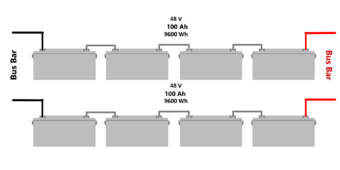Hi,
I put together my 2nd battery from 4 new Echo-Worthy 100Ah 12v batteries (to make 48v). I have 4 existing 100Ah 12v (in series for 48v) batteries that are currently running my system.
Here is my thinking. I think I need a balancer for the 4 existing batteries to keep them in sync with each other. Then I need another balancer for the 4 new batteries to keep them in sync with each other. Then I need a 3rd balancer to keep the two sets in sync with each other. I was thinking of buying 3 of these to do the job:
I was hoping I could get a BMS/balancer for all 8 batteries. My goal is to add 8 more at some point so they will all be slightly different. But it seems most of the BMS/balancers only work on cells that are 3.5v ish. Not on 12v "cells" like what I have.
So my question is: Is that they best way to do this or is there a better way?
I put together my 2nd battery from 4 new Echo-Worthy 100Ah 12v batteries (to make 48v). I have 4 existing 100Ah 12v (in series for 48v) batteries that are currently running my system.
Here is my thinking. I think I need a balancer for the 4 existing batteries to keep them in sync with each other. Then I need another balancer for the 4 new batteries to keep them in sync with each other. Then I need a 3rd balancer to keep the two sets in sync with each other. I was thinking of buying 3 of these to do the job:
I was hoping I could get a BMS/balancer for all 8 batteries. My goal is to add 8 more at some point so they will all be slightly different. But it seems most of the BMS/balancers only work on cells that are 3.5v ish. Not on 12v "cells" like what I have.
So my question is: Is that they best way to do this or is there a better way?





